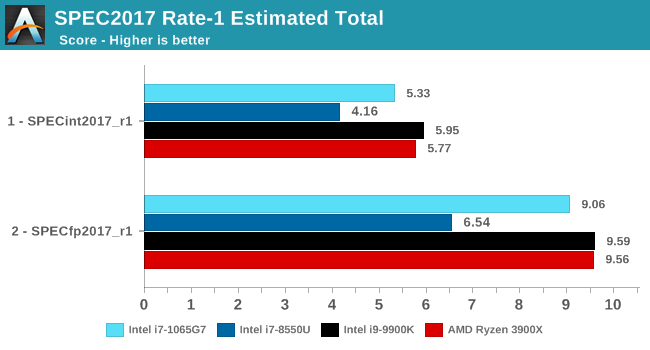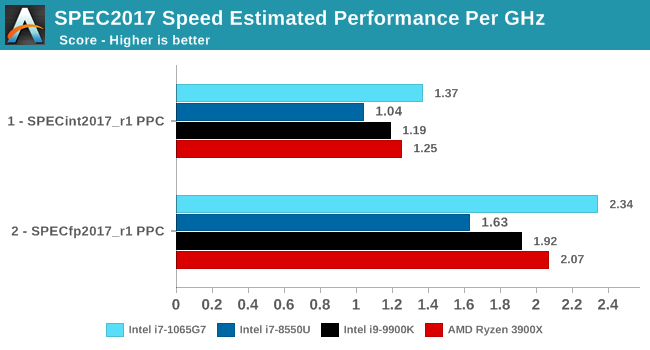The Ice Lake Benchmark Preview: Inside Intel's 10nm
by Dr. Ian Cutress on August 1, 2019 9:00 AM EST- Posted in
- CPUs
- Intel
- GPUs
- 10nm
- Core
- Ice Lake
- Cannon Lake
- Sunny Cove
- 10th Gen Core
Section by Andrei Frumusanu
SPEC2017 and SPEC2006 Results (15W)
SPEC2017 and SPEC2006 is a series of standardized tests used to probe the overall performance between different systems, different architectures, different microarchitectures, and setups. The code has to be compiled, and then the results can be submitted to an online database for comparsion. It covers a range of integer and floating point workloads, and can be very optimized for each CPU, so it is important to check how the benchmarks are being compiled and run.
We run the tests in a harness built through Windows Subsystem for Linux, developed by our own Andrei Frumusanu. WSL has some odd quirks, with one test not running due to a WSL fixed stack size, but for like-for-like testing is good enough. SPEC2006 is deprecated in favor of 2017, but remains an interesting comparison point in our data. Because our scores aren’t official submissions, as per SPEC guidelines we have to declare them as internal estimates from our part.
For compilers, we use LLVM both for C/C++ and Fortan tests, and for Fortran we’re using the Flang compiler. The rationale of using LLVM over GCC is better cross-platform comparisons to platforms that have only have LLVM support and future articles where we’ll investigate this aspect more. We’re not considering closed-sourced compilers such as MSVC or ICC.
clang version 8.0.0-svn350067-1~exp1+0~20181226174230.701~1.gbp6019f2 (trunk)
clang version 7.0.1 (ssh://git@github.com/flang-compiler/flang-driver.git
24bd54da5c41af04838bbe7b68f830840d47fc03)-Ofast -fomit-frame-pointer
-march=x86-64
-mtune=core-avx2
-mfma -mavx -mavx2
Our compiler flags are straightforward, with basic –Ofast and relevant ISA switches to allow for AVX2 instructions. Despite ICL supporting AVX-512, we have not currently implemented it, as it requires a much greater level of finesse with instruction packing. The best AVX-512 software uses hand-crafted intrinsics to provide the instructions, as per our 3PDM AVX-512 test later in the review.
For these comparisons, we will be picking out CPUs from across our dataset to provide context. Some of these might be higher power processors, it should be noted.
SPECint2006

Amongst SPECint2006, the one benchmark that really stands out beyond all the rest is the 473.astar. Here the new Sunny Cove core is showcasing some exceptional IPC gains, nearly doubling the performance over the 8550U even though it’s clocked 100MHz lower. The benchmark is extremely branch misprediction sensitive, and the only conclusion we can get to rationalise this increase is that the new branch predictors on Sunny Cove are doing an outstanding job and represent a massive improvement over Skylake.
456.hmmer and 464.h264ref are very execution bound and have the highest actual instructions per clock metrics in this suite. Here it’s very possible that Sunny Cove’s vastly increased out-of-order window is able to extract a lot more ILP out of the program and thus gain significant increases in IPC. It’s impressive that the 3.9GHz core here manages to match and outpace the 9900K’s 5GHz Skylake core.
Other benchmarks here which are limited by other µarch characteristics have various increases depending on the workload. Sunny Cove doubled L2 cache should certainly help with workloads like 403.gcc and others. However because we’re also memory latency limited on this platform the increases aren’t quite as large as we’d expect from a desktop variant of ICL.

In SPECfp2006, Sunny Cove’s wider out-of-order window can again be seen in tests such as 453.povray as the core is posting some impressive gains over the 8550U at similar clocks. 470.lbm is also instruction window as well as data store heavy – the core’s doubled store bandwidth here certainly helps it.

Overall in SPEC2006, the new i7-1065G7 beats a similarly clocked i7-8550U by a hefty 29% in the int suite and 34% in the fp suite. Of course this performance gap will be a lot smaller against 9th gen mobile H-parts at higher clocks, but these are also higher TDP products.
The 1065G7 comes quite close to the fastest desktop parts, however it’s likely it’ll need a desktop memory subsystem in order to catch up in total peak absolute performance.

Performance per clock increases on the new Sunny Cove architecture are outstandingly good. IPC increases against the mobile Skylake are 33 and 38% in the integer and fp suites, though we also have to keep in d mind these figures go beyond just the Sunny Cove architecture and also include improvements through the new LPDDR4X memory controllers.
Against a 9900K, although apples and oranges, we’re seeing 13% and 14% IPC increases. These figures likely would be higher on an eventual desktop Sunny Cove part.
SPEC2017



The SPEC2017 results look similar to the 2006 ones. Against the 8550U, we’re seeing grand performance uplifts, just shy of the best desktop processors.

Here the IPC increase also look extremely solid. In the SPECin2017 suite the Ice Lake part achieves a 14% increase over the 9900K, however we also see a very impressive 21% increase in the fp suite.
Overall in the 2017 suite, we’re seeing a 19% increase in IPC over the 9900K, which roughly matches Intel’s advertised metric of 18% IPC increase.










261 Comments
View All Comments
CharonPDX - Saturday, August 3, 2019 - link
Wow. 0.7 GHz? AKA 733 MHz? Like the Celeron I had back in 2000? (That overclocked like a *BOSS*, just crank the FSB up from 66 MHz to 100 MHz, and get 1.1 GHz.)AV_Stables - Sunday, August 4, 2019 - link
The best OC CPU Intel ever released was the Celeron 300A (had that at 598mhz) :) almost 100% OC, moved on to Pentium 3 Coppermine & Tulatin and an ES (clocked at 733) using the 920C (rambus) chipset (horror absolute) . But coming back to earth and reality this preview is just A PR exercise in customer retention. Sure the iGPU and cores are better, but come on people are you this easily won over. The Y series is more power hungry. Id rather you stick to actual released products, as many will see this as doing Intels' PR work for them as I do.voicequal - Sunday, August 4, 2019 - link
Given that the CPU is already starting to ship to OEMs, better to have hard facts and analysis from a trusted source than weeks more of rumor and speculation while we wait for an arbitrary public release date.AV_Stables - Monday, August 5, 2019 - link
Show me one in the wild and ill say fair do.guachi - Saturday, August 3, 2019 - link
Appreciate the preview. YouTube channel Hardware Unboxed highlighted your preview and made sure to tell viewers to come here and give you guys the views.As I'm a regular reader, I'm happy to do so.
albert89 - Saturday, August 3, 2019 - link
Is it really, really, really happening this time around ?HarryVoyager - Sunday, August 4, 2019 - link
It's probably already been asked an answered, and I've missed it in the thread or review, but how do we think these are likely to stack up against the current AMD CPUs for single thread performance? I noticed that they appear to have increased the per clock performance, but appear to have had to drop the clock rate to get that.The thing that's eating my PC's lunch is primarily VR flight simulators (Tomcat Tomcat Tomcat!), and I'm expecting the main ones are going to remain single thread performance dependent for the next 5 years or so.
Basically, if it stays in the 5%-10% range, and I'm still able to put together a machine that can do 45+ fps with a Ryzen 3000, then it make more sense to take that hit, but if we're looking at a 15-20% effective difference, then the Intel option becomes more meaningful.
I just wish the Il-2 or DCS teams would put together a good benchmarking tool...
Haawser - Sunday, August 4, 2019 - link
These are low power mobile chips, not desktop CPUs.voicequal - Sunday, August 4, 2019 - link
This Ice Lake part is targeted at mobile. If you need guaranteed single thread performance, you'd be better off with a desktop part that clocks higher and can operate at max frequency for an indefinite time without running into thermal or power budget limits.https://www.anandtech.com/show/14664/testing-intel...
This page show direct comparison with Ryzen 3900X, but it's only synthetics and doesn't normalize for frequency differences between the CPUs. That will surely come later in the full review.
Pizdatron - Monday, August 5, 2019 - link
Where are the 95W etc... variance , no info on that